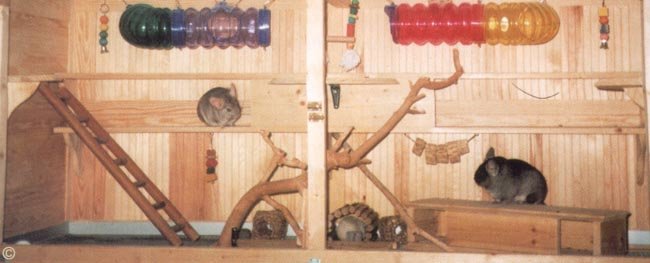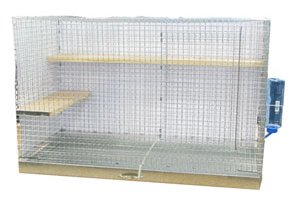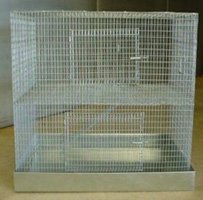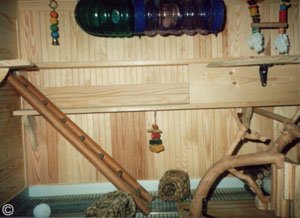
As the saying goes...Home is Where the Heart Is and the same goes for chinchillas. A chinchilla will spend most of its life within the cage confinement, therefore you must buy the correct type of cage and include all the necessary essentials.
The standard size chinchilla cage sold in pet shops is 18"-24" deep x 24"-36" wide x 24"-36" high and is only suitable for a lone chinchilla (at a minimum), so the first first thing you will need to consider when buying a chinchilla cage is whether you will be breeding chinchillas, keeping just one chinchilla or a pair of chinchillas.
If you are considering breeding chinchillas, then the female will need to be placed in a single story cage when the birth date is due so when the babies are born, no harm can come to them. Chinchilla kits are born with immediate mobility and begin to climb the walls of the cage and falling when getting to the top.
Chinchilla pairs need a cage that is big enough for two, plenty of places to hide in (bolt-holes) and toys to help distract attention from one another and a lone chinchilla will need a cage full of interesting items to play with to alleviate boredom.
Cages that have more empathise on length rather than height are better as they cover more floor area for a chinchilla to run and bounce around in. Unlike other rodents and small caged animal types, chinchillas like to use the walls of their cage for jumping on, bouncing off and running against when in the form of play. You must therefore ensure the side walls of the chinchilla cage does not contain holes bigger than ½ " x ½ " as chinchillas have been found hanging in the morning from a trapped leg or foot!
The position of the cage has an impact on a chinchilla's feeling of security and comfort so it is paramount that a chinchilla's cage is positioned in the correct location within your household
A chinchilla cage should be housed in a room that is quiet, light, airy, cool with an ideal room temperature between 60°-75°F (15.5°-25°C). Chinchillas can very easily suffer from 'heat stroke' or death in environments in excess of 75°F together with high humidity levels, so make sure the room you house the chinchilla's cage in is kept cool during warmer climates.
The chinchilla cage must be large enough for a chinchilla to be able to run and jump about (remember, chinchillas can just up to 6ft in the air). If the chinchilla's cage is too small they will suffer from various disorders such as depression, extreme anxiety and neurotic habits, which will result in the chinchilla pacing in circles or somersaulting, loose the ability to jump or run properly.
The best location for a chinchilla cage is in the corner of a quiet room, away from radiators, draughts, sunlight and any objects that could be in reach of the chinchilla (for example curtains and wires). As animals of prey, chinchillas like to be housed high up therefore use a sturdy table and position the chinchilla cage at eye level. It is also a good idea to place a sheet over the chinchilla cage giving them an extra sense of security during their sleeping hours in the daytime. You can leave a small peep-hole gap at one end so when the chinchilla is awake and ready for interaction you will find them approach the opening to see where you are and then you can remove the covering.
Below is further information on the different types of chinchilla cage you can choose.
 Wire Bottom Cage
Wire Bottom Cage
This is the most common type of chinchilla cage and is made from galvanized wire with mesh holes ½ " x ½ ". A wired bottom cage is one of the most hygienic cages for a chinchilla as faeces and waste debris can pass through the bottom into a separate collection tray underneath. The tray can be lined with newspaper for easy cleaning and maintained without having to remove the chinchilla from its cage.
The size of the wire mesh is an important factor if you want to be sure to keep the chinchilla safe. Some chinchillas have been known to trap their feet or leg between the mesh therefore you must ensure the holes are no bigger than ½ " x ½ ". The ideal would be ¼ " x ¼" especially if your chinchilla will be having babies. A great idea is to scatter untreated wood around the bottom of the cage for a chinchilla to jump onto and prevent such injuries as broken bones or trapped limbs.
 Solid Bottom Cage
Solid Bottom Cage
This type of chinchilla cage is the most safest for a chinchilla and any potential babies but is harder to keep hygienically clean. The bottom of the cage is usually detachable and can be lined with hay or newspaper but unfortunately, with this type of chinchilla cage, there is no where for the waste to go, therefore a chinchilla will come into direct contact with waster debris, urine and faeces. The bottom of the cage will need to be cleaned daily to prevent fungus setting into the flooring and infections.
Used Cage
If you choose to use a chinchilla cage that has already housed a previous chinchilla, it is essential that you not only clean it thoroughly but also disinfect the cage to avoid any build up of bacteria that will be harmful to your chinchilla. You must especially pay attention disinfecting the corners of the chinchilla cage, which are dark and a perfect breeding ground for fungus and bacteria before rinsing thoroughly with fresh water.
You must disinfect a used chinchilla cage 48 hours before you place a new chinchilla inside to ensure the cage has been allowed to air dry thoroughly and is not damp. The process of disinfecting a used wired bottom cage is much easier than sterilizing a solid bottom cage. Solid bottom cages tend to hold the scent of previous chinchillas no matter how much you clean, so if you choose a used chinchilla cage, pick the wired bottom cage type, which will be easier to clean and disinfect.
Home Made Cage
 Many owners like to design their own type of chinchilla cage, which is perfectly fine and understandable. Thorough research must be undertaken before you attempt to build your own cage and you should only try this is you are completely experienced. One caution you must remember is to ensure the chinchilla cage is completely safe before allowing a chinchilla to roam free and jump about inside. If successful you can create a wonderful home environment for a chinchilla of any size and layout but if not it can kill them! Some home made chinchilla cages have been known to collapse on chinchillas or are toxic because of the products the owner chose to use. You must never build a chinchilla cage out of chicken wire, wood other than natural untreated pine, wire that is coated in plastic and never under any circumstances use a glass aquarium. Make sure when you build a chinchilla cage the door can be securely fastened as chinchillas can work out how to open cage doors and also that the hole is big enough to be able to remove houses and all other other items within the cage.
Many owners like to design their own type of chinchilla cage, which is perfectly fine and understandable. Thorough research must be undertaken before you attempt to build your own cage and you should only try this is you are completely experienced. One caution you must remember is to ensure the chinchilla cage is completely safe before allowing a chinchilla to roam free and jump about inside. If successful you can create a wonderful home environment for a chinchilla of any size and layout but if not it can kill them! Some home made chinchilla cages have been known to collapse on chinchillas or are toxic because of the products the owner chose to use. You must never build a chinchilla cage out of chicken wire, wood other than natural untreated pine, wire that is coated in plastic and never under any circumstances use a glass aquarium. Make sure when you build a chinchilla cage the door can be securely fastened as chinchillas can work out how to open cage doors and also that the hole is big enough to be able to remove houses and all other other items within the cage.
Outdoor Cage
Chinchilla cages should never be housed outside unless you have some type of heating system to regulate the temperature. A chinchilla can die outside if not kept properly so you will have to be more vigilant. A chinchilla will be more prone to predators, stress and fluctuations in the British climate, let alone the chances of the chinchilla escaping - never to be caught again (only by a predator). It is seriously inadvisable to house a chinchilla and the cage outside so you must choose a quiet room within your home environment.
A chinchilla cage does not smell if regularly cleaned. Keep to a cleaning routine and perform husbandry on a day, weekly, monthly and twice-yearly basis.
Further Reading Relating To Chinchilla Cages:
Cage Necessities/Essentials, Cage Maintenance.





 Many owners like to design their own type of chinchilla cage, which is perfectly fine and understandable. Thorough research must be undertaken before you attempt to build your own cage and you should only try this is you are completely experienced. One caution you must remember is to ensure the chinchilla cage is completely safe before allowing a chinchilla to roam free and jump about inside. If successful you can create a wonderful home environment for a chinchilla of any size and layout but if not it can kill them! Some home made chinchilla cages have been known to collapse on chinchillas or are toxic because of the products the owner chose to use. You must never build a chinchilla cage out of chicken wire, wood other than natural untreated pine, wire that is coated in plastic and never under any circumstances use a glass aquarium. Make sure when you build a chinchilla cage the door can be securely fastened as chinchillas can work out how to open cage doors and also that the hole is big enough to be able to remove houses and all other other items within the cage.
Many owners like to design their own type of chinchilla cage, which is perfectly fine and understandable. Thorough research must be undertaken before you attempt to build your own cage and you should only try this is you are completely experienced. One caution you must remember is to ensure the chinchilla cage is completely safe before allowing a chinchilla to roam free and jump about inside. If successful you can create a wonderful home environment for a chinchilla of any size and layout but if not it can kill them! Some home made chinchilla cages have been known to collapse on chinchillas or are toxic because of the products the owner chose to use. You must never build a chinchilla cage out of chicken wire, wood other than natural untreated pine, wire that is coated in plastic and never under any circumstances use a glass aquarium. Make sure when you build a chinchilla cage the door can be securely fastened as chinchillas can work out how to open cage doors and also that the hole is big enough to be able to remove houses and all other other items within the cage.